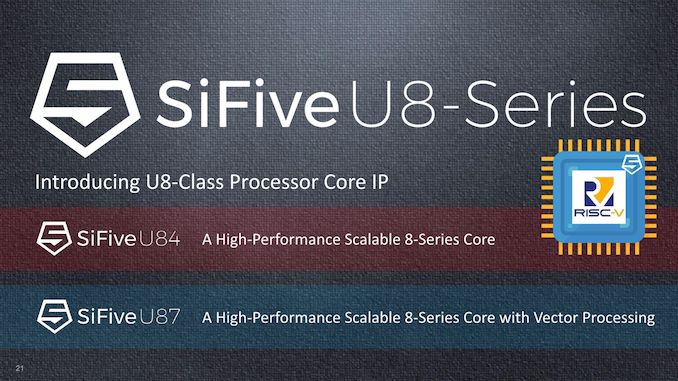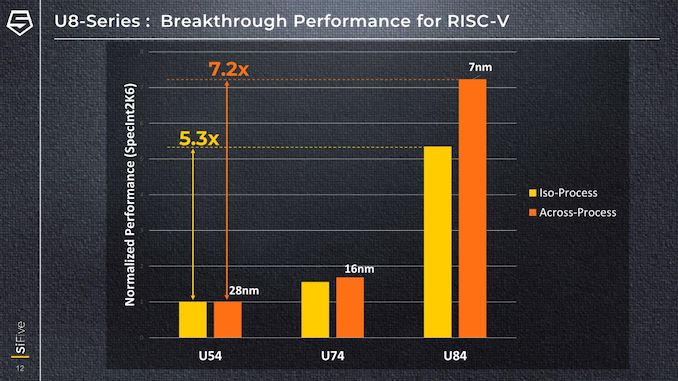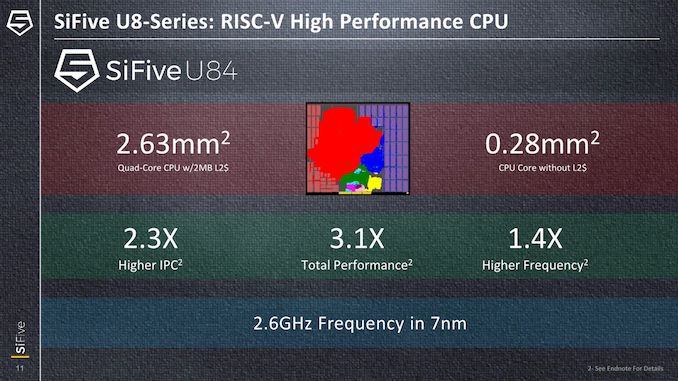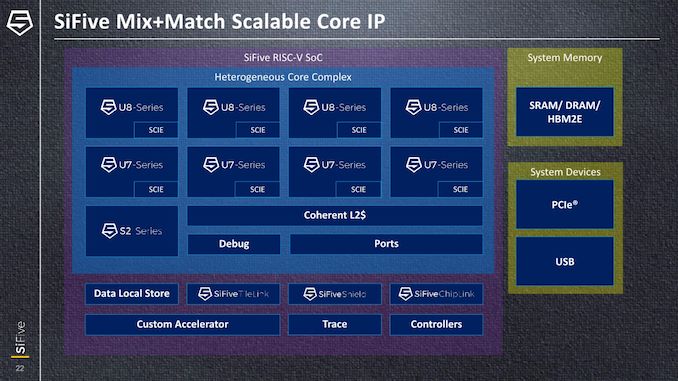SiFive Announces First RISC-V OoO CPU Core: The U8-Series Processor IP
by Andrei Frumusanu on October 30, 2019 10:00 AM ESTPerformance Targets, PPA and Conclusion
The U8-Series microarchitecture will initially be productized as two IP offerings: The U84 and the U87 CPU cores:
The U87 will only be available later next year, whilst the U84 is also being finalised right now. The company has the U84 IP running internally on FPGA platforms.
The performance increases compared to previous generation SiFive cores are extremely impressive: Against a U54 at ISO-process, the new U84 features a 5.3x performance increase in SPECint2006. When taking into account the process node improvements that allow the U84 to clock higher, the generational increases that we’d be seeing in products will be more akin to a factor of 7.2x.
In terms of PPA, compared to a U7-series CPU, IPC increases come in at 2.3x resulting in 3.1x higher performance (ISO-process). A lot of the performance increases of the U8-series come thanks to the increased frequencies capabilities which are 1.4x higher this generation, with the core scaling up to 2.6GHz on 7nm.
On the same 7nm process, the U84 lands in at 0.28mm² per core and a cluster comprising four cores and a 2MB L2 cache measure in at 2.63mm². For comparison, a Arm Cortex-A55 as measured on the Kirin 980, also on 7nm, a core with its 128KB private L2 cache comes in at 0.36mm². Given that SiFive promises of similar performance to a Cortex-A72, which in turn would be more than double the performance of an A55, it looks like SiFive’s U84 core would be extremely competitive in terms of its PPA.
Finally, SiFive is able to configure of up to 9 CPU cores into a coherent cluster with a shared L2. The IP is also able to this in a heterogeneous way, similar to Arm’s big.LITTLE approach, employing both U8 and U7 series and even S-Series CPUs into the same cluster.
Conclusion - A Big Step In a Long Journey
Overall, SiFive’s new U8 core is I think a very important and major step for the company in terms of pushing its products and as well as pushing the RISC-V ecosystem forward. The key takeaway from the U8 is the massively improved performance of the core that now suddenly allows the company to seriously compete against some of Arm’s low- and mid-range cores.
I’m not really expecting to see the core employed in products such as smartphones any time soon as frankly SiFive still has a very long road ahead in terms of improving absolute performance. That being said, in the IoT and embedded markets, I think we’ll see faster and wider adoption of RISC-V cores, and SiFive is certain to see continued growth and interest for years to come. We’re looking forward in observing this future develop.














68 Comments
View All Comments
The_Assimilator - Wednesday, October 30, 2019 - link
Half a decade and they don't even have a production part with SIMD or vector capabilities? Arm has nothing to worry about.bji - Wednesday, October 30, 2019 - link
That seems particularly short-sighted. Your criteria for ARM needing to worry apparently is production silicon with vector capabilities and according to this article that will be available next year.PeachNCream - Wednesday, October 30, 2019 - link
It is a valid point right now to argue that RISC-V isn't a threat while production parts are not available to purchase. Ad present, even if I wanted to acquire a competing product, I would be unable to due to the lack of ability to make an acquisition. The situation may change next year, but we won't know until we see what both ARM and RISC-V look like at that point. The dynamics may change on both sides of that coin after time has passed.bji - Wednesday, October 30, 2019 - link
Strawman. He didn't say they are not a threat. He said ARM has nothing to worry about. The distinction is slim I admit and also just semantic, but the sentiment I read from The_Assimilator was more about how this company has not produced a product that ARM would need to worry about in half a decade and by saying that ARM has nothing to worry about, implies that they will not be producing any product that would compete with ARM for a long time. But the article states that the will be releasing the product that The_Assimilator says compete with ARM next year, and any company would naturally worry about a competing product that close on the horizon.In terms of being threatened, ARM cannot be threatened by something that cannot exist. But they may want to worry, i.e. take seriously the notion that a competitor may be threatening them soon.
bji - Wednesday, October 30, 2019 - link
"by something that cannot exist" should have been "by something that does not exist". Post editing, Ananadtech-style!PeachNCream - Wednesday, October 30, 2019 - link
Okay, that's cool.There's never anything wrong with competitive designs. Either way, we are likely to enjoy improvements that result from various interests attempting to get ahead of one another so it's good all the same no matter what the outcome.
Sivar - Wednesday, October 30, 2019 - link
ARM was able to take over because of its inherent advantage over x86: Efficiency. As R&D advanced, ARM cores like the Apple A* line and Qualcomm Snapdragon have slowly worked towards Intel-level performance.MIPS has no large inherent benefit over ARM, but it has some of the same disadvantages vs. x86 such as larger executable code size. MIPS is an elegant architecture and lacks some of the strange baggage the architectures have (read about THUMB some time) but the story of semiconductors does have elegance as a main protagonist. See Intel's history of success as an example.
rrinker - Wednesday, October 30, 2019 - link
Indeed, back in the early 8 bit days, the RCA CDP1802 was absolutely the most elegant architecture, but most people probably day "the what?". Outside of some niche applications, where the completely static nature allowed it to clock down to 0 and draw picoamps, and it being all CMOS so low power even when running, and being available in rad hardened form, it was all but invisible in the pre-IBM PC 8 bit days. Elegance doesn't equal design wins.Sivar - Wednesday, October 30, 2019 - link
Interesting, I hadn't heard of this. I wonder if the same principles could be applied to idle processors today. Now if only Android would let the CPU go idle for more than a few ms.rrinker - Wednesday, October 30, 2019 - link
The registers and such aren't static though, I don't think, on most modern processors, so they have to run at some minimum clock rate to be refreshed. Unused elements can be turned off today, and with turbo you have varying frequency, but the old 1802 could run from 0-4MHz (or 6, or 8, or as high as 12MHz in the last variants. It was almost RISC-like, as well, just 91 instructions, and that very well organized (for Hex, Intel just loved Octal so the 8080 instruction set it highly aligned for octal - it makes no sense in hex). Most 1802 contemporaries had a very small register count - the 1802 has 16x16 general purpose registers plus accumulator and a coupe others. Of the 16, any one could be program counter, which could be switched on the fly (that's how they did subroutine calls with no CALL instruction), and any could be the index pointer for memory directed operations, also switchable on the fly, which means the 1802 has the best operand ever - SEX, for SEt indeX. It was my first computer, and later when I had to add an assembly routing to an Apple 2 BASIC program to get proper performance, I was hugely frustrated by the lack of registers int he 6502. SO many people worship the 6502, I frankly hated the thing. 1802 remains my favorite 8-bitter, followed by the Z80. Best part is, that computer I built from a kit more than 40 years ago still works perfectly.